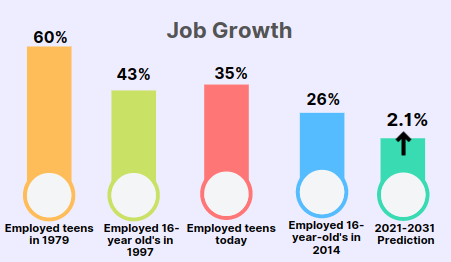Job outlook on the rise again

Job growth statistics
December 2, 2022
Over the past few months, the number of citizens unemployed has significantly increased, especially in the month of September. The lack of job growth is occurring all over America, leading many to blame this on the work ethic of the younger generation.
After the month of August, the U.S Bureau of Labor Statistics (BLS) is seeing hopeful change and has predicted a 2.1% increase in that amount of people starting to work again from the ranges between 2021-2031. Reports by the BLS have shown that COVID-19 is largely to blame for the start of the national crisis our economy fell into with the lack of workers.
“Around last spring, I started to realize an increase in employers looking for workers because of Covid, and they’re still struggling [to fill all positions],” junior Camie Jones said.
According to the Washington Post, “When the first millennials turned 16 in 1997, teen employment was above 43 percent. When the last of their generation hit 16 in 2014, it had plunged to around 26 percent.”
There have been many reports showing that the younger generation has played a role in the downfall of total citizens contributing to the workforce. The Washington Post explains this to back the theory that, as time goes on, technology advances, and people get lazier.
I have influenced a few of my friends to get a job, [my friends that do work, say it’s] because they need money. [I] mainly hear that alot of my friends that dont work [say it’s] because of sports and [jobs]. ” junior Briana Deese said.
High school students have been having a hard time getting back on track with school since the COVID-19 pandemic, so working is definitely a next step that some kids may not be ready to throw onto their plates quite yet. COVID-19 has even caused most teens to have social anxiety, although working may help that for some, others just simply are too scared for this big step in life.
“[Working] has made me more social, [but] when it comes to characteristics, I [do not] think [I have] [personally] gained much because [I have] always been responsible with money and responsible in general,” Deese states.
Some of the short-term effects can look like rise in inflation, rising wages, and supply chain issues. The long-term effects that can be expected could look like: slow down of GDP growth, cause a recession, and could even hinder the growth of industries with all jobs such as manual and even blue-collar jobs.
Some specific job fields in need of the most help are financial advisors, business managers, and health promotion specialists. Lots of jobs that have taken a hard hit over the past years because of the amount of people who are needing medical attention, leading to burn-out healthcare workers and causing some to quit.
“Right now in school, I’m doing my health science [classes to prepare for] next year’s internship. My sister wanted to [go into the medical field] and that’s what made [me look further into it].” Jones states.
CNBC News reports show “In 1979, nearly 60% of American teenagers were employed, an all-time high, although today, just over one-third, or 35%, of teens between the ages of 16 and 19 are part of the workforce.” Indications show kids are turning the majority of their attention to grades and academics Junior Carolina Chavez shares her tactics on how she is able to maintain all A’s in her classes.
“I only work Fridays and Saturdays, [and] I just go in on Saturdays if I can, [as long as] I don’t have soccer,” Chavez said.
Having a job as a teenager ultimately instills work ethic among young teens. Money teaches teens many lessons.
“[I want] to get my own money, so I can feel like I have responsibilities,” Chavez said.


